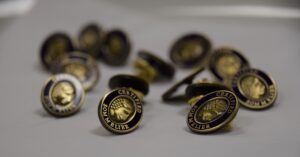
Touring around a Hampshire vineyard this summer, I struck up a conversation with a gentleman who seemed to know an awful lot about wine, and sparkling wine in particular. Well-travelled and wealthy, he spoke at length about his wine experience in a bid to impress both the owner of the vineyard, and the rest of the tour group. As we made our way back into the tasting room, he recommended some places to eat back in town, reassuring me that we would be able to find something “affordable.”
“Millennials are confident in their knowledge, keen to try different wines, and willing to spend more per bottle on average than those over 55 years old.”

I thanked him politely and went on to enjoy my flight of sparkling while privately questioning if the enjoyment of fine food and wine requires age and experience. Truth be told, most on the tour were probably in the 30-45 range, dressed in sundresses, summer shorts, and sneakers; they knew what they were looking to taste in a sparkling wine, and asked intelligent questions. They were, as it turns out, just like me.
Indeed, wine tasting is no longer the domain of stuffy experts, and not only for those who are building cellar collections and drinking for prestige. More than ever, younger folks are turning to English sparking wine because it’s fun (and delicious), and they don’t see the need to wait for celebratory occasions such as weddings or New Year’s Eve.
According to Wine Intelligence, much of the recent acceleration in the sparkling wine category is coming primarily from the urban affluent consumer aged under 45 – principally the Millennial (classified as those born between 1981 and 1996) and early Gen-Z (1996-2010) cohorts. Although these two groups represent just 26% of the wine drinking population, they account for roughly 50% of all on-premise wine spend. Our recent visit confirmed this – following our tour, most of the visitors our age not only picked up a bottle to bring home, but also purchased one on ice to enjoy in the vineyard, often accompanied by a grazing platter of Hampshire cheeses and olives.
Until recently, sparkling wine was viewed as a drink for special occasions – and even then folks tended to lean toward French Champagne as a signifier of wealth, social status and, yes, quality too. Sparkling varieties were consumed not by 30-45 year olds but, rather, by their parents. Things, however, have changed and among many Millennials, sparkling has become the beverage of choice for casual social gatherings, end of the work week celebrations, and even regular happy hours. Moreover, these younger drinkers may not be as affluent as their wealthy “boomer” parents, but are willing to spend more money, particularly in urban centres. Most interesting? While overall wine consumption seems to be trending in the other direction, with older drinkers increasing consumption of still wine options, it’s all about sparkling for the younger crowd.
According to a report released by the International Wine and Spirits Competition (IWSC), Gen Z and Millennial consumers exhibit much different behaviours when purchasing wine. Compared to their elders, this younger demographic is buying more, opting for statement formats (i.e. magnums) and regularly choosing expensive fizz over more economical options such as Prosecco or Cava. As The Drinks Business claims, Millennials are “confident in their knowledge, keen to try different wines, and willing to spend more per bottle on average than those over 55 years old.”
These trends towards youth are not only reflected in wine purchasing and consumption, but also in education and investment. Statistics show that WSET (Wine & Spirit Education Trust) numbers are higher than ever in the UK while those who receive prestigious Sommelier Qualification distinctions are skewing younger and younger. Moreover, wine is increasingly being seen as a viable investment opportunity among young people. In 2022, for instance, the magazine Club Enologique revealed that the average bidder at wine auctions has shifted from 65 to 40 years old in less than a decade.
And let’s not discount the power of technology, of looking good and “showing off” for peers, and the “fear of missing out” (FOMO) that continues to guide Millennial and Gen Z behaviours across all consumer goods sectors. According to the IWSC, wine experiences and “wow-factors” that are worthy of sharing via social media channels will be the key to further unlocking the potential of Gen Z and Millennial purchasing power, as they “enjoy grandstanding in front of friends and loved ones when celebrating, and their wine purchases need to deliver Insta-worthy moments.”
What then does this mean for marketing UK sparkling wine and harnessing Millennial and Gen Z consumer trends?